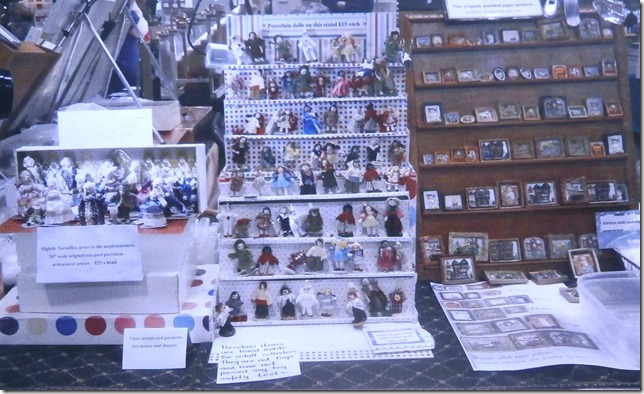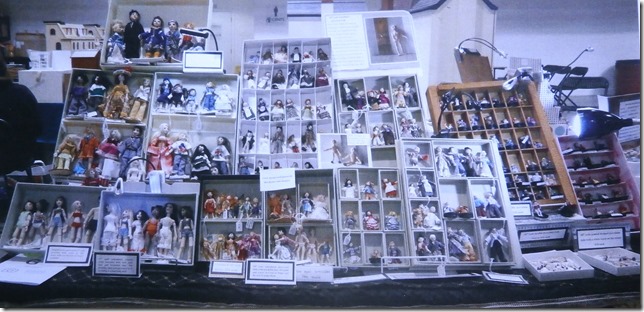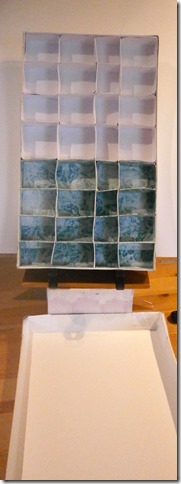Boxes have figured so largely in my life, had I known at the outset how important they were, I’d have worked for a box manufacturer or been a box manufacturer. I need boxes.
Historically boxes are ancient and important. Mediaeval chests had lugs or channels on the sides so they could be carried from place to place by the insertion of poles. They were by no means the earliest chests. Ancient Romans had wonderful chests, fabulously decorated, whether they were the chests under their armorial breastplates or the cassone at the bottom of the bed. When on the tour of the Vatican apartments I saw numerous beautiful chests. Roman chests were copied originally from the people who were there before them, the Etruscans. They had carved marble or stone chests which have survived well. The tombs of Etruscan nobility took the form of a chest in the shape of a bed with the body in the chest and an effigy, reclining on the top.
The first chests of which we have many good examples are those of the ancient Egyptians, who used their chests to store possessions, body parts and, of course their sarcophagi to store their mummies.
Whether in them, terribly dead, or using them, very alive, chests are important. When I designed my craft room I promptly filled it with metal chests of drawers, cupboards, stacking boxes, bookcases filled with chests and boxes and boxes that stack on the boxes, the boxes under the table are stacked on other boxes and the trolleys (on wheels) have boxes in them too. If work on an item is suspended due to intrusion of reality, I put all the bits in a box and put the lid on. The fact that most of these boxes are transparent does not prevent a trawl of the boxes being a time travel visit to Ali Baba’s cave. I have an A5 two-stack in my bedroom which will be the Seaside Miniatures quarter scale French café which I was going to show you how to build, when I have finished building it. I didn’t finish building it, reality intruded and I boxed it. If you ever read about it here you’ll know I was sufficiently bored to open the boxes. Boredom is rare round here. I treasure boredom. If you suffer from boredom, I’d recommend getting some boxes and putting half finished projects in them. A lot of the boxes are paper crafting stuff. If had had just done dolls I might be the best in the world by now, or I’d have given up completely and actually finished any of the novels I’m writing. Thanks to boxes I can do lots of different things without feeling the need to finish any of them.
Boxes are essential for anyone with what rude people call a butterfly mentality and those in the know refer to as a miniaturist. Getting a dolls’ house is good early training for being at least halfway competent in most things and genuinely interested in everything. My first house was the start of my interest in social history, which has continued apace through television programmes, books and some more books, empirical research at various locations, a lifetime’s antiques’ knowledge and visits to anywhere of historical interest. I didn’t set out to be a history buff, it just happened courtesy of a dolls’ house, to the point where I am beginning to pick up errors in works published by professors who have written stuff based on book learning and didn’t bother to go and check it out.
However, the boxes currently of interest are the show boxes. At one of the earliest shows I did PTM (prior to Miniatura), the OH was ‘helping’. I had a wooden stage which he had built and I had covered in velvet, which took up most of the car and elevated the dolls which could be propped up on the velvet without slipping. At the time I had not invented my doll stands and couldn’t afford metal doll stands, so the dolls, some undressed and just in breakable porcelain, travelled in a small plastic tool chest. The helpful OH, having inserted the wooden stand in the car, was in ‘mighty man’ mode. He took the plastic toolbox out to the drive and balanced it on the edge of the car boot. I do not know why. I have never known why, I have thought of it often and not come up with an answer.
Left, balanced on the edge of a car boot, filled with unstable, breakable porcelain dolls, not packed with any kind of packing, just laid one upon the other, gravity intervened.
No survivors.
Thirty one years later, with up to a thousand items, mostly dolls, to put on a table, I have learned of the importance of boxes. A box that will transport dolls safely and display them in recesses in the box so that they look attractive, are supported, can be easily reached for examination and put back in the same box, safely and easily by any miniaturist, is the box for me. The perfect one is either the holy grail of boxes or the holey box of dolls.
Some of the boxes are display in themselves, like slight Versailles on the left. The dolls travel each on a stand in the box, which has a lid. They are cushioned by their massive eighteenth century clothing. Come to think of it, it must have been practically impossible for a lady in full sacque gown, or extensive panniers, to fall over. Even if liberally overserved with champagne to the point of being comatose, with a wooden board up the front of you and ever-spreading whalebone hoops from your waist to the ground, the most that could happen is that you could nod off to the point where the ship in full sail on your wig, suddenly beached on the parquet.
The middle box contains the 2 inch collectable dolls. Once the dolls are removed to their travelling box, which has layers of foam, the top half turns to tesselate with the bottom half and the lot fits into the shoebox which the top half is standing upon. The bas relief paper pictures on the end, which I developed for cereal box miniaturists, whose walls will not support a canvas wood framed picture, all go in a biscuit tin with layers of fine foam.
It’s when you get to the long end with the dolls in three scales, that boxes get tricky.
It takes a long time to make, eye, china paint, assemble, wig and dress the articulated dolls. I could never appear at a show with 20 new dolls, because the process is so lengthy. Therefore the dolls travel in smaller boxes, so that I can move them around and never have an empty box. These are the twelfth scale on the left. In the middle are the articulated twenty-fourth, my favourite scale and type, which is why there are so many in a divided box that was, originally, a shirt box, which happened fortuitously to divide perfectly by the height of the dolls. Divided and strengthened the box is just the right size to travel in the padded craft trolleys where they live, to the show. As I age the wisdom of investing in these, originally very expensive, trolleys, has become apparent. I even invested in the three main trolleys before I broke both arms, otherwise the break from exhibiting would have had to wait until the breaks in the bones had regained sufficient strength to heft huge bags, which is what I previously used.
Then we come to the villains of the piece. Starting with the wooden box on the right. This is a printer’s tray.
There was a while in miniatures, round about the mid eighties, when you could pay such large sums of money for printer’s trays that fake ones began to appear in antique shops. The fake ones were inferior. They were of unseasoned wood, bedecked with splinters and the dividers were often not glued to the back. Real printer’s trays have the patina of age and many ink stains.
I first met printer’s trays in the seventies. Working in the language college it was part of my job to take students on a trip round the offices of the local paper, the Nottingham Evening Post, at exactly the point where they were changing from printer’s trays to electronic. Half the pages were printed one way and half another. To elucidate, in case your knowledge of print is not extensive, since Caxton, pages have been printed by assembling all the letters that make the words, backwards into a frame. The frame is inked and pressed onto the paper which makes an impression the right way round. By the late twentieth century printers were skilled at picking individual letters out of divided trays. These are the printer’s trays, which became available to collectors at the point at which type could be sent from a computer to a press, bypassing the type-picking phase altogether. The empty wooden trays, with a gloss of antiquity, have small divisions, making fabulous wall-hung cases for miniature display, especially if you can devise a way of stopping the miniatures falling out.
I began using printer’s trays for show display when I first started making twenty-fourth scale dolls. Propped up at the top end, they nicely filled the table and were as accessible for picking dolls as they had been for picking print. As my stock grew I no longer had a huge flat table to fill, so a half tray has come back, as you see in the photo, for the forty-eighth scale dolls.
It is only helping out the other boxes. The other boxes for the forty eighth, are Marks and Spencer macaron trays. These boxes which have windows and are easy to strengthen, have the massive advantage that it necessary to empty them of macarons, following purchase. I have a cupboard and a box full of macaron trays, having discovered that my granddaughter is keen to do her bit in tray emptying.
But I need more space. The higgeldy-piggeldy collection of boxes must go. In their place one new custom built box, very strong but also not wooden or hard in any way and two different colours, for easy identification of forty-eighth, jointed from bendy, at a whole £2 difference, is now made, and all the glue has dried.
Behold the box and the lid. If you are a forty-eighth collector this is what to look out for next time.
It’s amazing how much you learn, selling at fairs. It isn’t just the items for sale you have to design and make, it is the stand to display them, and the means to pack it away for travel safely.
Bob Hopwood was well-known for telling new exhibitors ‘You know what you are selling, don’t you? With everything you put on the table, you are selling yourself.’
In which case I am my boxes.
Zen as all get out.
~~~~~~~~~~~~~~~~~~~~~~~~



